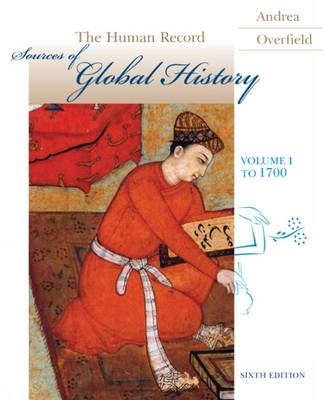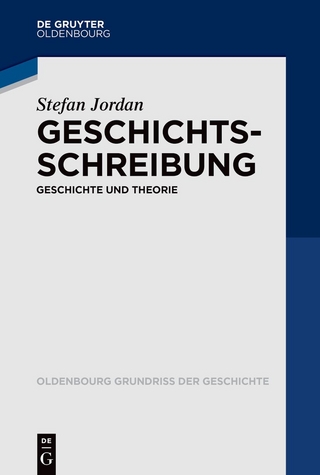
The Human Record
Houghton Mifflin (Verlag)
978-0-618-75110-5 (ISBN)
- Titel ist leider vergriffen;
keine Neuauflage - Artikel merken
Now in its Sixth Edition, The Human Record continues to be the leading primary source reader for the World History course. Each volume contains a blend of visual and textual sources; these sources are often paired or grouped together for comparison. A prologue entitled, "Primary Sources and How to Read Them," appears in each volume and serves as a valuable pedagogical tool. Unlike many world history texts that center on the West, The Human Record provides balanced coverage of the global past. Approximately one-third of the sources in the Sixth Edition are new, and these documents continue to reflect the myriad experiences of the peoples of the world.
Alfred Andrea received his Ph.D. from Cornell University. He is Professor Emeritus of History at the University of Vermont, where he taught from 1967 through 2001. His initial training concentrated on medieval European history, with an emphasis on Byzantine-Western relations and the Crusades. He has since published four books on the Crusades, as well as numerous articles on a variety of historical issues. For the past thirty years, his teaching, research, and writing have focused increasingly on world history before 1600, with a particular interest in cross-cultural contacts across the Silk Road. In 2002 he was Distinguished Scholar-in-Residence at the University of Louisville, and he served as president of the World History Association (WHA) in 2010-2012. In 2014, the WHA recognized him as a Pioneer of World History. James H. Overfield, Professor Emeritus at the University of Vermont, received his BA from Dension University, his MA from the University of Chicago, and his PhD from Princeton University. During his career at Vermont he received the University’s outstanding teacher award, and served many years as Department of History Chair, in which capacity he was a strong advocate for the study and teaching of global history. His publications include Humanism and Scholasticism in Late Medieval Germany (Princeton University Press, 1984), as well as numerous articles on late medieval and early modern European thought. He served as editor for three volumes (1750-1914) of the ABC-CLIO World History Encyclopedia and is author of Sources of Global History since 1900 (Cengage: 2013).
PART ONE: THE ANCIENT WORLD.
1. The First Civilizations.
Mesopotamia: The Epic of Gilgamesh; The Judgments of Hammurabi. Egypt: The Person Who Was Tired of Life; Tale of the Eloquent Peasant. China: The Book of Documents; The Book of Songs. Mute Testimony: Indus Seals, Mesopotamian Seals, and Cretan Seals; Two Temple Reliefs.
Multiple Voices I: A Pyramid Text; A Coffin Text; The Negative Confession.
2. Newcomers: From Nomads to Settlers.
The Indo-Europeans: The Rig Veda; Homer, The Odyssey. The Israelites and Their Neighbors: The Book of Genesis; The Book of Deuteronomy.
3. Transcendental Reality: Developing the Spiritual Traditions of India and Southwest Asia: 800-200 B.C.E.
The Emergence of Brahminical Hinduism: The Upanishads; The Bhagavad-Gita. The Teachings of the Buddha: The Buddha, Setting in Motion the Wheel of the Law; The Buddha, Questions That Tend Not to Edification. Persians, Israelites, and Their Gods: Zarathustra, Gathas; The Book of Isaiah.
4. The Secular Made Sacred: Developing the Humanistic Traditions of China and Hellas: 600-200 B.C.E.
China: Laozi, The Classic of the Way and Virtue; Confucius, The Analects; Qin Shi Huangdi, Qin Penal Laws. Hellenic Civilization: Thucydides, History of the Peloponnesian War; Euripedes, The Bacchae; Plato, Phaedo; Three Hellenic Works of Art.
Multiple Voices II: The Yellow Emperor's Classic of Internal Medicine; Testimonials At Epidauros; Hippocrates, On the Sacred Disease
5. Regional Empires and Afro-Eurasian Interchange: 300 B.C.E.-500 C.E.
The Greco-Roman World: Four Hellenistic Sculptures; Virgil, The Aeneid. Han China: Huan Kuan, Discourses on Salt and Iron; Ban Zhao, Lessons For Women. India in the Age of Empires: Asoka, Rock and Pillar Edicts; Faxian, Travels
Multiple Voices III: Pliny the Elder, Natural History; Faxian, Travels; Four Robed Statues
PART TWO: FAITH, DEVOTION, AND SALVATION: GREAT WORLD RELIGIONS TO 1500
6. New Developments in Three Ancient Religions
Mahayana Buddhism: Tales of Guanshiyin; Three Bodhisattvas. Bhakti: Narada, The Bhakti Sutra; Shiva Naturaja. Rabbinical Judaism: Flavius Josephus, Against Apion; The Babylonian Talmud.
7. Christianity: Conquering the World for Christ
The Foundations of Christianity: The Gospel of Saint Matthew; Saint Paul, Epistle To the Romans. Christianity and the Roman World: Eusebius of Caesarea, Ecclesiastical History; The Theodosian Code; Christ the Redeemer of the World. Beyond the Roman World: Rufinus of Aquileia, Church History; Bishop Adam, The Christian Monument.
Multiple Voices IV: The Gospel of Thomas; Irenaeus, Against Heresies; Homilies of Clement; Eusebius of Caesarea, Ecclesiastical History; The Creed of Nicaea.
8. Islam: Universal Submission to God
The Foundations of Islamic Life: The Quran; Abu Abdullah ibn Ismail al-Bukhari, The Authentic [Traditions]; Muhammad ibn Ishaq, The Life of the Messenger of God; Abu al-Walid Muhammad ibn Ahmad Ibn Muhammad ibn Rushd, The Distinguished Jurist's Primer. Variety and Unity within Islam: Ibn Babawayh al-Saduq, Creed Concerning the Imams; Mahmud Kati, The Chronicle of the Seeker; Jalaluddin al-Rumi, Spiritual Couplets.
Multiple Voices V: The Pact of Ibn Muslama; The Pact of Umar; Benjamin of Tudela, Book of Travels; The Deeds of Sultan Firuz Shah.
PART THREE: CONTINUITY, CHANGE, AND INTERCHANGE: 500-1500
9. Asia: Change in the Context of Tradition
Japan: Chronicles of Japan; Sei Shonagon, The Pillow Book; Chronicle of the Grand Pacification. China: Du Fu, Poems; The Old Tang History; Chen Pu, The Craft of Farming. Southwest Asia: Al-Jahiz, The Merits of the Turks and of the Imperial Army As a Whole; Ibn Jubayr, Travels; A Thousand and One Arabian Nights. India: Abul Raihan al-Biruni, Description of India; Vikrama's Adventures.
Multiple Voices VI: Shi Baochang, Lives of the Nuns; Han Yu, Memorial on Buddhism; Proclamation Ordering the Destruction of Buddhist Monasteries; Zhu Xi, Conversations of Master Zhu, Arranged Topically.
10. Two Christian Civilizations: Byzantium and Western Europe
Justinian the Great: The Mosaics of San Vitale; Michael Psellus, Chronographia. Charles the Great: Pope Leo III's Lateran Mosaic; Charles the Great, Capitulary on Saxony and Letter To Pope Leo III. Byzantium and the West in the Age of Otto the Great: Liudprand of Cremona, A Report on the Embassy To Constantinople; A Byzantine Icon of the Koimesis and A Dormition Miniature. Imperium versus Sacerdotium: Dictatus Papae; Henry IV, Letter To Hildebrand; John of Paris, A Treatise on Royal and Papal Power; Anna Comnena, Alexiad.
Multiple Voices VII: Baldric of Dol, The Jerusalem History; Anna Comnena, Alexiad; Robert of Clari, The Capture of Constantinople; Nicetas Choniates, Annals; Innocent III, Letters To the Crusaders.
11. Africa and the Americas
Africa: Abul-Hasan Ali al-Masudi, Meadows of Gold; Abu Ubaydallah al-Bakri, The Book of Routes and Realms; Ethiopian Royal Chronicle; . Seated Female Figure. The Americas: Three Mayan Ceramic Sculptures; Diego Durán, Book of the Gods and Rites; Pedro de Cieza de León, Chronicles.
PART FOUR: TRAVEL, ENCOUNTER, AND EXCHANGE: 1000-1700
12. Adventurers, Merchants, Diplomats, Pilgrims, and Missionaries: A Half Millennium of Travel and Encounter: 1000-1500
The World Perceived: Zhau Rugua, A Description of Foreign Peoples; The Book of John Mandeville; The Kangnido. Travel in the Age of the Pax Mongolica: William of Rubruck, Journey To the Land of the Tartars; Marco Polo, Description of the World; Odoric of Pordenone, Report; Francesco Pegolotti, The Practice of Commerce. Long-Distance Travel beyond the Mongol Peace: Ibn Battuta, A Donation To Those Interested in Curiosities; Ruy González de Clavijo, Embassy To Tamerlane; Huan, The Overall Survey of the Ocean's Shores; Gomes Eannes de Azurara, The Chronicle of Guinea.
13: Transoceanic Encounters: 1500-1700
Europeans in the Americas: Bernardino de Sahagún, General History of the Things of New Spain; Antonio Vazquez de Espinosa, Compendium and Description of the West Indies. African Reactions to the European Presence: Nzinga Mbemba (Afonso I), Letters To the King of Portugal; A Benin-Portuguese Saltcellar and A Benin Wall Plaque; . James Barbot, A Voyage To New Calabar River in the Year 1699. Chinese and Japanese Reactions to the West: Matteo Ricci, Journals; Tokugawa Iemitsu, Closed Country Edict of 1635 and Exclusion of the Portuguese; 1639. The Great Mughals and the West: Abul Fazl, Akbarnama; Jean-Baptiste Tavernier, Travels in India.
Multiple Voices VIII: Hernan Cortés, Report; Bernal Díaz del Castillo, The History of the Conquest of New Spain; Bernardino de Sahagún, General History of the Things of New Spain; Lienzo De Tlaxcala.
| Erscheint lt. Verlag | 28.1.2008 |
|---|---|
| Verlagsort | Boston |
| Sprache | englisch |
| Maße | 192 x 233 mm |
| Gewicht | 813 g |
| Themenwelt | Geisteswissenschaften ► Geschichte ► Geschichtstheorie / Historik |
| ISBN-10 | 0-618-75110-6 / 0618751106 |
| ISBN-13 | 978-0-618-75110-5 / 9780618751105 |
| Zustand | Neuware |
| Haben Sie eine Frage zum Produkt? |
aus dem Bereich


